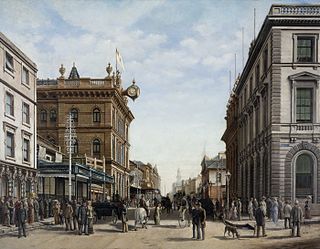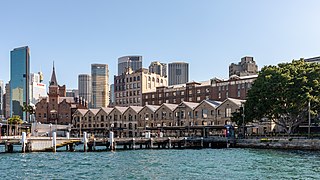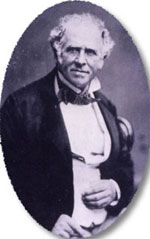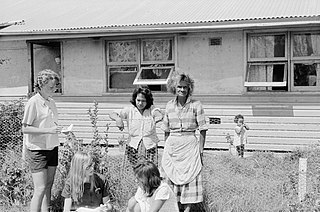
Arthur Phillip was a British Royal Navy officer who served as the first governor of the Colony of New South Wales.

New South Wales is a state on the east coast of Australia. It borders Queensland to the north, Victoria to the south, and South Australia to the west. Its coast borders the Coral and Tasman Seas to the east. The Australian Capital Territory and Jervis Bay Territory are enclaves within the state. New South Wales' state capital is Sydney, which is also Australia's most populous city. In December 2021, the population of New South Wales was over 8 million, making it Australia's most populous state. Just under two-thirds of the state's population, 5.3 million, live in the Greater Sydney area.

Sydney is the capital city of the state of New South Wales, and the most populous city in Australia. Located on Australia's east coast, the metropolis surrounds Sydney Harbour and extends about 70 km (43.5 mi) towards the Blue Mountains to the west, Hawkesbury to the north, and the Royal National Park and Macarthur to the south and south-west. Greater Sydney consists of 658 suburbs, spread across 33 local government areas. Residents of the city are colloquially known as "Sydneysiders". The estimated population in June 2022 was 5,297,089; the city is home to approximately 66% of the state's population. The city's nicknames include the "Emerald City" and the "Harbour City".

The Sydney Conservatorium of Music is a heritage-listed music school in Macquarie Street, Sydney, New South Wales, Australia. It is one of the oldest and most prestigious music schools in Australia. Located adjacent to the Royal Botanic Gardens on the eastern fringe of the Sydney central business district, the conservatorium is a faculty of the University of Sydney, and incorporates the community-based Conservatorium Open Academy and the Conservatorium High School. In addition to its secondary, undergraduate, post-graduate and community education teaching and learning functions, the conservatorium undertakes research in various fields of music. The building was added to the New South Wales State Heritage Register on 14 January 2011.

The history of Sydney is the story of the peoples of the land that has become modern Sydney.

The Rocks is a suburb, tourist precinct and historic area of Sydney's city centre, in the state of New South Wales, Australia. It is located on the southern shore of Sydney Harbour, immediately north-west of the Sydney central business district.

Nepean River, is a major perennial river, located in the south-west and west of Sydney, New South Wales, Australia. The Nepean River and its associated mouth, the Hawkesbury River, almost encircles the metropolitan region of Sydney.
The history of Australia from 1788 to 1850 covers the early British colonial period of Australia's history. This started with the arrival in 1788 of the First Fleet of British ships at Port Jackson on the lands of the Eora, and the establishment of the penal colony of New South Wales as part of the British Empire. It further covers the European scientific exploration of the continent and the establishment of the other Australian colonies that make up the modern states of Australia.

Catherine Elizabeth Grenville is an Australian author. She has published fifteen books, including fiction, non-fiction, biography, and books about the writing process. In 2001, she won the Orange Prize for The Idea of Perfection, and in 2006 she won the Commonwealth Writers' Prize for The Secret River. The Secret River was also shortlisted for the Man Booker Prize.

Larissa Yasmin Behrendt is an Australian legal academic, writer, filmmaker and Indigenous rights advocate. As of 2022 she is a professor of law and director of research and academic programs at the Jumbunna Institute for Indigenous Education and Research at the University of Technology Sydney, and holds the inaugural Chair in Indigenous Research at UTS.

Lieutenant Colonel George Barney was a military engineer of the Corps of Royal Engineers and became Lieutenant Governor of the Colony of North Australia.
Barangaroo was the second wife of Bennelong, who was interlocutor between the Aboriginal people and the early British colonists in New South Wales. Barangaroo was a member of the Cammeraygal clan. While Bennelong spent considerable time in the British settlement in Sydney, Barangaroo maintained her way of life with her people.
John McGarvie was a Scottish-born Australian Presbyterian minister and writer.

Ann Curthoys, is an Australian historian and academic.
Maria Kavallaris is an Australian scientist, based at the University of New South Wales' Children's Cancer Institute, where she is best known for her contributions to the field of cancer research. On 25 January 2019, Kavallaris was appointed a member of the Order of Australia.
Christina Louise Twomey, is an Australian historian and academic.
Joan Ross is an Australian artist based in Sydney who works across a range of mediums including drawing, painting, installations, sculpture and video. Her work investigates the legacy of colonialism in Australia, particularly the effects colonialism has had on Indigenous Australians.
Heather Goodall, is an Australian academic and historian. She is Emeritus Professor at the University of Technology Sydney. Her research and writing focuses on Indigenous and environmental history and intercolonial networks.
Penelope Ann Russell, is an Australian social historian. She is Bicentennial Professor of Australian History at the University of Sydney.
Glenda Margaret Halliday is an Australian neuroscientist. As of 2021, she is a professor at the University of Sydney and research fellow in the National Health and Medical Research Council (NHMRC). She was named 2022 NSW Scientist of the Year.











